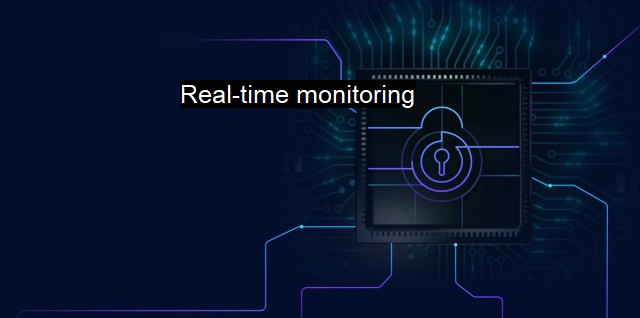What is Real-time monitoring?
Why Real-time Monitoring is an Essential Function in Cybersecurity: Proactive Measures for Detecting and Preventing Potential Security Threats
Real-time monitoring is a perceptive and practical approach to cybersecurity that offers robust defense against threats to digital assets, networks, and systems. Invariably, it involves taking all the necessary cybersecurity measures, both active and passive, and observing results simultaneously.Unlike traditional security solutions like periodic scanning, which only highlight the vulnerabilities when the scanning is complete or in intervals, real-time monitoring ensures vigorous security inspection in real time. It continuously scans, examines, and categorizes all activities across the network landscape with an unflinching vigilance, immediately identifying and flagging any malicious attempts aimed at compromising the system or information security, every fraction of a second.
Various tools and technologies are used for real-time monitoring. An intrusion detection system (IDS) is a significant aspect of real-time monitoring in cybersecurity. This functions by actively looking for suspicious patterns or anomalies in network activity capable of indicating a harmful intrusion. Given that cyber threats have exponentially evolved into sophisticated, dynamic and continuously changing forms, system logs and network traffic are processed through complex algorithms capable of discerning any unusual patterns of behavior. Importantly, IDS has mechanisms such as risk scoring that facilitate understanding the severity of a detected anomaly.
Another essential technology is the Antivirus software, incorporated with real-time scanning functionality. Unlike the conventional on-demand scanning, real-time scanning assessment delivers an immediate response time. Irrespective of where the virus originated, whether from emails or downloads, its entire attempt in penetrating the system is tracked and immediately tackled preventing further damages.
Security Information and Event Management (SIEM) system is another cornerstone of real-time monitoring. By combining Security information management (SIM) and Security event management (SEM), SIEM system offers a holistic view of an organization's information security. It collects and examines data streams in real-time from different resources to evaluate and analyze for potential threats, which include monitoring of event logs, handling security-related incidents, and facilitating compliance. any unusual activity would be promptly highlighted, limiting the damage zone, while strengthening security vigilance.
In the modern world where businesses are relying significantly on digital tools and online operations, real-time monitoring is unarguably indispensable. By enabling organizations to detect and tackle potential security threats proactively, real-time monitoring equates to lower chances of information breach, unauthorized access, data theft, or a malevolent attack by ensuring fewer gaps that these evildoers can exploit.
Notably, real-time monitoring is not limited to detecting threats. It also offers an invaluable comprehension into an organization's network operations. It identifies problems that may otherwise obstruct smooth operation or cause system malfunctions or slowdowns. Such insights can help entities optimize performance, improve responsiveness, and propel operational efficiency to new heights.
Real-time monitoring is the future of cybersecurity. It transforms a reactive approach into a proactive one, prompting an immediate action against each possible danger as and when they arise. While it incurs a significant investment in relevant hardware, software, and technology infrastructure, an organization's data security's long-term return-on-investment is immeasurable. Hence, for firms seeking to foster strong cybersecurity posture, real-time monitoring indispensably should be incorporated as an integral part of the strategic plan.

Real-time monitoring FAQs
What is real-time monitoring in the context of cybersecurity and antivirus?
Real-time monitoring in cybersecurity and antivirus refers to the continuous and automated monitoring of systems, networks, and applications to detect and respond to security incidents in real-time. It involves monitoring various parameters such as user activity, network traffic, system logs, and file changes to identify any suspicious or malicious activities.What are the benefits of real-time monitoring in cybersecurity and antivirus?
Real-time monitoring helps organizations to detect and respond to security incidents quickly, reducing the impact of cyber-attacks. It enables security teams to identify and investigate potential threats, assess the risk, and take appropriate actions to mitigate the risk. Real-time monitoring also helps organizations to comply with regulatory requirements and improve their security posture over time.What tools are used for real-time monitoring in cybersecurity and antivirus?
There are various tools and technologies used for real-time monitoring in cybersecurity and antivirus, including Security Information and Event Management (SIEM) systems, Intrusion Detection and Prevention Systems (IDPS), Endpoint Detection and Response (EDR) solutions, and Network Traffic Analysis (NTA) tools. These tools collect and analyze huge amounts of data, detect anomalies and threats, and generate alerts or automated responses to mitigate the risk.How can real-time monitoring help in incident response in cybersecurity and antivirus?
Real-time monitoring plays a crucial role in incident response in cybersecurity and antivirus. It enables security teams to detect and respond to security incidents in real-time, reducing the time to detect and contain the incident. Real-time monitoring provides visibility into the entire IT infrastructure, helping security teams to identify the root cause of the incident and take appropriate actions to remediate it. With real-time monitoring, organizations can also learn from past incidents and improve their incident response capabilities over time.| | A | | | B | | | C | | | D | | | E | | | F | | | G | | | H | | | I | | | J | | | K | | | L | | | M | |
| | N | | | O | | | P | | | Q | | | R | | | S | | | T | | | U | | | V | | | W | | | X | | | Y | | | Z | |
| | 1 | | | 2 | | | 3 | | | 4 | | | 7 | | | 8 | | |||||||